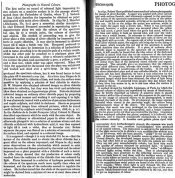Well, I'm an oldbb but I don't quite get it either. I think (and I'm opening myself eagerly to correction) that we are dealing with two principles here.
In the days of albumen printing which began in about the 1860's and still has adherents (Linda Connor is a prominent name here) papers could be simply printed in sunlight (or under UV today) and they would darken with the exposure to light. They didn't need to be developed chemically. They would need to be fixed to keep them from continuing to darken under continued exposure to light, such as one needs to view them. For a long time, photographers made proofs for portrait clients on "POP" (printing out paper) because they weren't permanent. If the client framed the pic, it would get darker and darker until it disappeared altogether. Current materials will do this to some extent, perhaps some more than others. Typically, the densities achievable this way are pretty wimpy. With REAL POP papers, they were stunning.
The other principle that comes to mind is Solarization. Seems to me that "solarprint" suggests this. When we speak of "solarization" usually what is meant is not solarization at all, but the Sabbatier effect (look up Man Ray, if that term eludes you). True solarization is an actual reversal. If you expose, as St. Ansel did, and Wynn Bullock also, long enough with the bright disk of the sun in the image, the sun will actually begin to LOSE density in the image. You can look up the images; they are invariably titled "Black Sun". I have done this also. It is not really hard, it is just that you don't get it to happen automatically; luck is still a factor. The way this works is that the characteristic curve of a film is only 1/2 of the whole curve; it is actually something like a "bell curve". Given enough exposure, the response will produce a mirror image of the curve we know so well and love. There were pre-solarized products offered which would automatically produce positive images from exposures with positives.
So, with a six month exposure, one MIGHT achieve sufficient density, as well as a true and thorough solarization.
Am I right?






